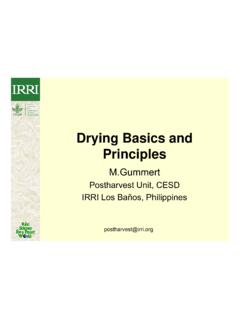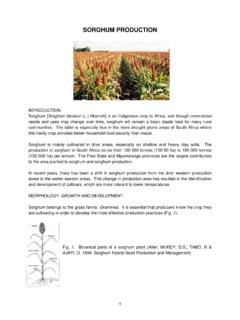Transcription of 12 Steps Required for Successful Rice Production
1 28 IRRI Rice Production Manual IRRI is the world's premier research organization dedicated to reducing poverty and hunger through rice science;. improving the health and welfare of rice farmers and consumers; and protecting the rice-growing environment for future generations. Headquartered in the Philippines and with offices in 17 countries, IRRI is a global, independent, nonprofit research and training institute supported by public and private donors. IRRI breeds and introduces advanced rice varieties that yield more grain and better withstand pests and disease as well as flooding, drought, and other harmful effects of climate change. The Institute develops new and improved methods and technologies that enable farmers to manage their farms profitably and sustainably. IRRI recommends rice varieties and agricultural practices suitable to particular farm conditions and consumer preferences.
2 Finally, IRRI. assists national agricultural research and extension systems (NARES) in formulating and implementing national rice sector strategies and programs. IRRI is a member of the CGIAR consortium and, among global partners, leads the Global Rice Science Partnership (GRiSP), which provides a single strategic plan and unique new partnership platform for impact-oriented rice research for development. The responsibility for this publication rests with the International Rice Research Institute. Published by the International Rice Research Institute Copyright International Rice Research Institute 2015. This publication is copyrighted by the International Rice Research Institute (IRRI) and is licensed for use under a Creative Commons Attribution-NonCommercial-ShareAlike License (Unported). Unless otherwise noted, users are free to copy, duplicate, or reproduce, and distribute, display, or transmit any of the articles or portions of the articles, and to make translations, adaptations, or other derivative works under the following conditions: Attribution: The work must be attributed, but not in any way that suggests endorsement by IRRI or the author(s).
3 NonCommercial: This work may not be used for commercial purposes. ShareAlike: If this work is altered, transformed, or built upon, the resulting work must be distributed only under the same or similar license to this one. For any reuse or distribution, the license terms of this work must be made clear to others. Any of the above conditions can be waived if permission is obtained from the copyright holder. Nothing in this license impairs or restricts the author's moral rights. Fair dealing and other rights are in no way affected by the above. To view the full text of this license, visit Suggested citation: Rice Production Manual, Los Ba os (Philippines): International Rice Research Institute. Mailing address: IRRI, DAPO Box 7777, Metro Manila, Philippines Phone: +63 (2) 580-5600. Fax: +63 (2) 580-5699. Email: Web: Rice Knowledge Bank: Courier address: Suite 1009, Security Bank Center 6776 Ayala Avenue, Makati City, Philippines Tel.
4 +63 (2) 891-1236, 891-1174, 891-1258, 891-1303. ISBN 978-971-22-0313-8. Steps at a glance Lessons Page Step 1. Use a crop calendar 3. Step 2. Choose the best variety 5. Step 3. Use high quality seed 7. Step 4. Prepare and level the fields well 9. Step 5. Plant on time 11. Step 6. Weed early 13. Step 7. Fertilize to maximize returns 15. Step 8. Use water efficiently 17. Step 9. Control pests and diseases effectively 19. Step 10. Harvest on time 21. Step 11. Store safely 23. Step 12. Mill efficiently 25. Step 13. Understand the market 27. Steps to Successful rice Production 1. A crop calendar is a picture of your rice growing season: crop Production from the fallow, land preparation, crop establishment, and maintenance through harvest and storage. By using a crop calendar, farm activities are better planned, and performed at the right time. It is easier to organize labor and obtain inputs such as seed and fertilizer.
5 Better planning will decrease input costs and increase yields. How to create a crop calendar 1. Determine the best date to plant. 2. Determine the time the variety takes from planting to harvest (short- duration, 100 120 days; medium duration, 120 140 days; long duration, 160. days or more). 3. Most varieties take 50 55 days from panicle initiation to harvest. 4. Mark on the calendar the date of planting and when each other operation needs to be done (plowing, weeding, fertilizing, and harvesting). 5. Pin the calendar in a prominent place to remind you when things need to be done. Steps to Successful rice Production 3. The most suitable variety is the one best meeting farmer's and consumer's needs. It may not always give the highest yield and will be influenced by availability of water (either from rain or irrigation), soil type, and field elevation, and whether the rice will be sold or consumed at home.
6 Varieties should be selected based on good yield potential, resistance to disease, good eating qualities, high milling yield, and are suitable for the market. When selecting a variety check the following: Crop duration Long-duration varieties (160 days and longer) suitable for irrigated areas or flood-prone areas Medium-duration varieties (120 140 days) suitable for both rainfed and irrigated areas Short-duration varieties (less than 120 days) suitable for drought-prone areas or for double cropping. Crop height Tall varieties ( m and taller) are suitable for flood-prone and unleveled fields, lodging may be a problem. Medium height varieties (1 m) are suitable for most areas and are not as susceptible to lodging when fertilizer is used. Short varieties are best suited to level fields especially in irrigated areas. They are responsive to fertilizers and are normally less than 1 m in height.
7 Grain quality A premium is often paid for aromatic varieties, but yields are normally lower. Eating quality such as softness, stickiness, and color after cooking are important. Steps to Successful rice Production 5. High-quality seed reduces the Required seeding rate and produces strong, healthy seedlings, resulting in a more uniform crop with higher yields. Good seed is: Clean with no stones, soil, or weed seed ;. Pure containing grains of one variety; and Healthy having full big grains of the same color with no cracks or spotting. High-quality seed can be bought as certified seed or produced by the farmer. Produce high-quality seed 1. Select a level field with well-maintained bunds and easy access. 2. Use clean, pure, and healthy seed . 3. Do a float test on the seed before planting and remove any seeds that float. 4. Use good management practices by planting on time, applying fertilizer, weeding before 21 days after establishment, and not letting weeds go to seed .
8 5. Rogue the fields by removing all rice plants that clearly look different during the vegetative, flowering, and grain-filling stages. 6. Harvest at full maturity when 80 85% of the grains are straw-colored or at 21 22% moisture. 7. Thresh and dry quickly after harvest. 8. Store seed safely and label containers or bags with variety name and date of harvest. Steps to Successful rice Production 7. A well-prepared and leveled field gives a uniform, healthy crop that can compete with weeds, use less water, and give higher yields at a lower cost. A well-prepared field has: Many small soil clods to give good seed -soil contact clod size and seed size are similar;. No weeds;. Harder plowlayer at 10 cm to stop water penetration;. Level and smooth surface after working; and Well-constructed bunds. To prepare the field When possible, plow immediately after the previous harvest especially if the soil is still moist.
9 First or primary plowing. Use a disc or moldboard plow to kill weeds and incorporate crop residue, preferably 6 8 weeks before planting with maximum depth of 10 cm. Second plowing. Plow across the field with the disc or tine harrow at least twice to make small clod sizes. Second plowing should be 2 3 weeks before planting and the last harrowing 1 week before planting with maximum depth of 5 cm. Repair bunds, destroy rat burrows, repair any holes and cracks, and re- compact the bunds. Bunds should be at least m high and 1 m wide. Leveling the field will give better water coverage, better crop establishment, and better weed control. Soil puddling should be done at least 1 2 days before seeding to allow the water to clear when direct seeding. Steps to Successful rice Production 9. Planting the crop on time will help produce a fast-growing, uniform crop that will have higher yields and will be better able to compete with weeds and pests.
10 The best time to plant depends on the locality, variety, water availability, and the best harvest time. Rice can either be transplanted from a nursery or direct-seeded in the field. Transplanted crops will normally take less time in the Production field but 10 15 days longer for the total crop duration. In both cases, a well prepared seedbed is needed. For transplanted crops: Wet direct seeding: 1. Select a nursery site that is 1/10 in size 1. Pre-germination of seed . Soak the of the intended planting area. seed for 24 hours and then drain 2. Prepare the nursery by plowing at least for 24 hours in the shade before twice and harrow at least once. broadcasting evenly over the 3. Level the soil surface and put in water-covered soil surface. drainage lines across the field. 2. Broadcast pre-germinated seed at 4. Pre-germination and sowing. Soak the 100 kg/ha seed for 24 hours and then drain for 3.







